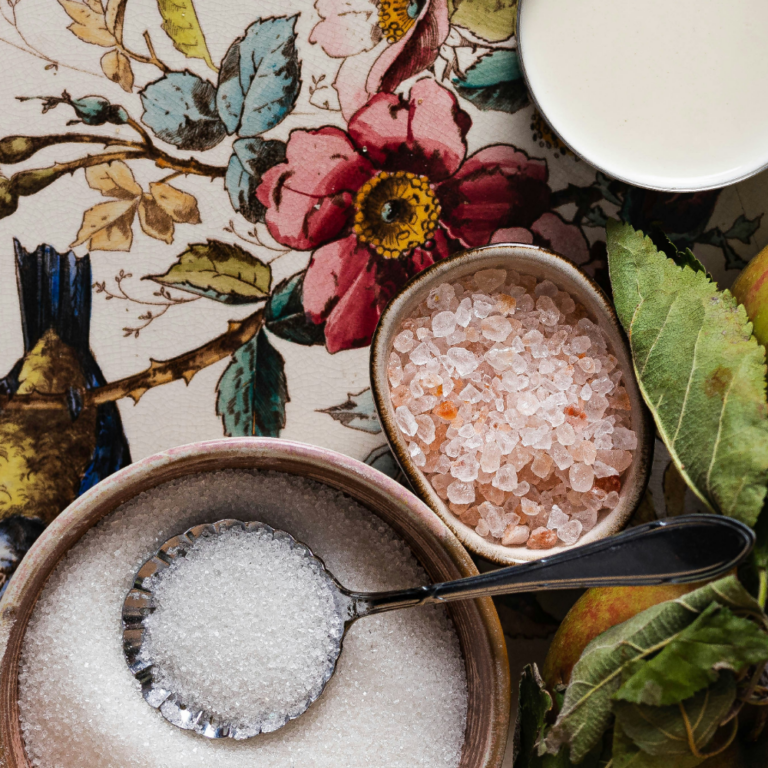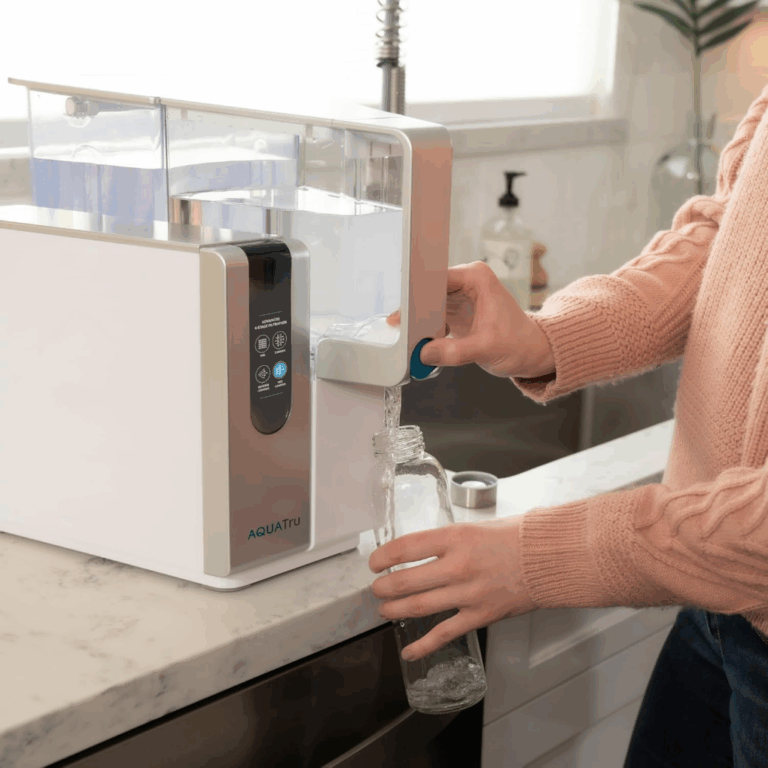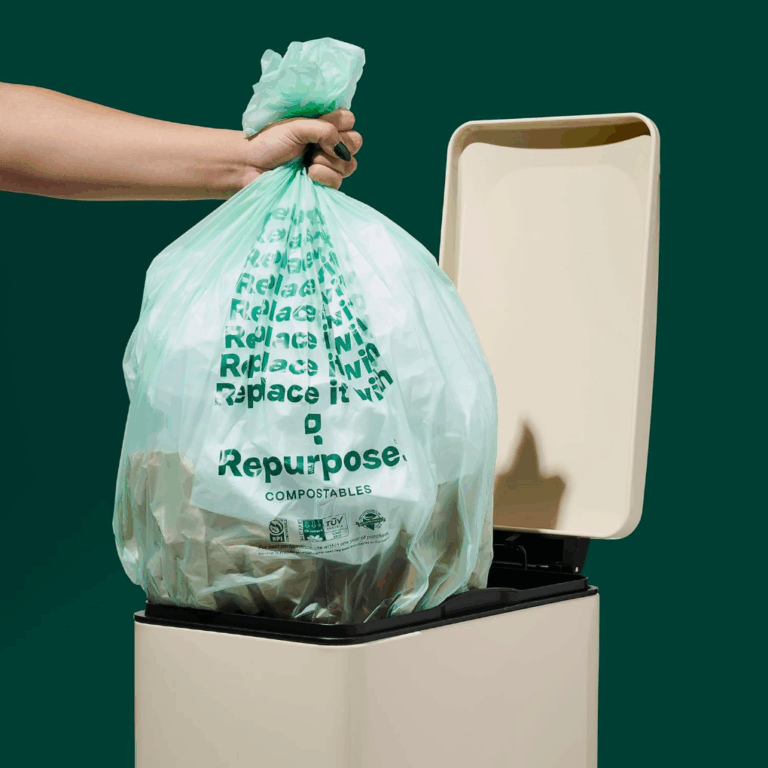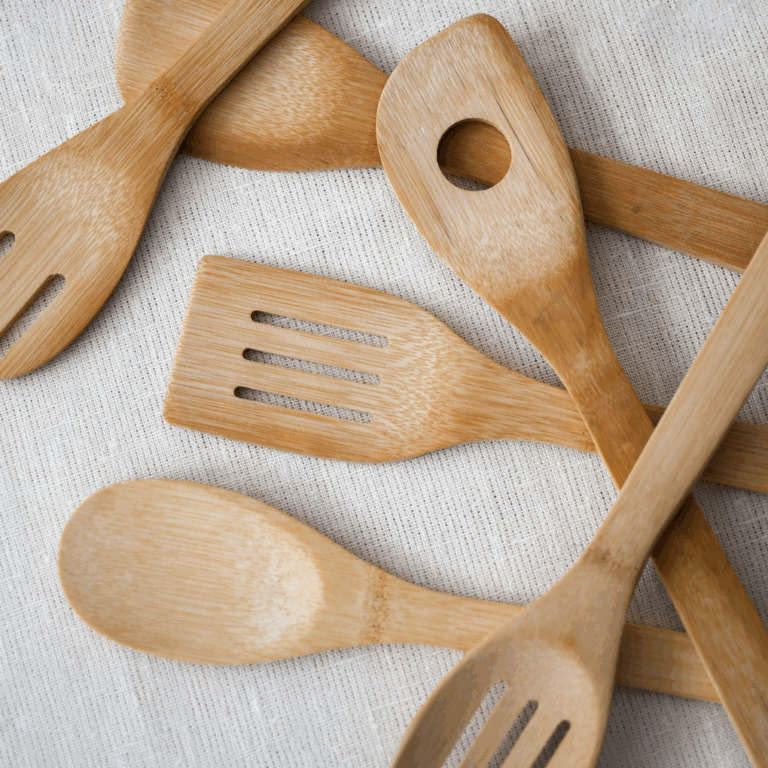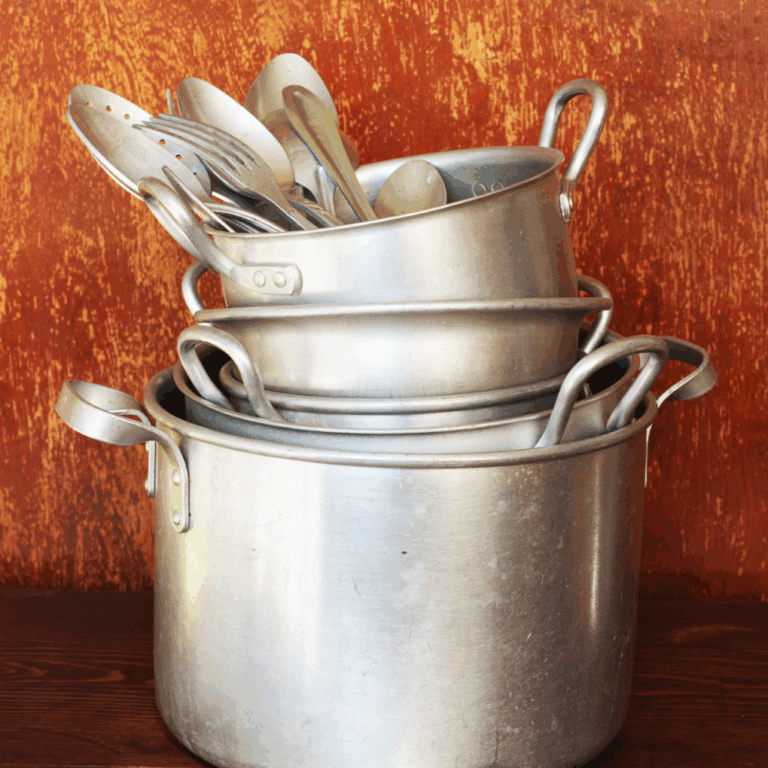
Key Takeaways
- Plastic-free water bottles avoid chemicals like BPA and microplastics, keeping your water clean and safe.
- Options like stainless steel and glass provide better taste, strong durability, and a healthier alternative to plastic.
- Investing in a reusable plastic-free bottle helps reduce waste and saves money long-term.
If you’re tired of contributing to the 1 million plastic bottles purchased every minute around the world, you’re in good company. Ditching plastic water bottles is one of the easiest ways to reduce single-use waste, and switching to a plastic-free alternative doesn’t mean giving up convenience or performance. Once you find the right one, it’s hard to go back.
Reducing how much plastic you use isn’t just about cutting out chemicals like BPA. It’s about using materials that are safer, sturdier, and more sustainable. The right bottle won’t mess with the taste of your water or fall apart after a few months. It’ll withstand daily use and feel like something you want to carry with you.
Whether you’re looking for an insulated bottle to keep your drinks hot or cold or something lightweight and minimalist for your desk or gym bag, there are a few key materials that stand out. Each comes with its pros and quirks. Here’s what to know before making the switch.
Why Choose Plastic-Free Water Bottles?
Plastic bottles seemed convenient until I learned about the harm they’re causing to our health and the planet. Here’s what convinced me to make the switch:
- The Health Reality: Even “BPA-free” plastic bottles can leach chemicals like phthalates and microplastics into your water. I noticed my water tasted different after leaving plastic bottles in my car or dishwasher. With stainless steel and glass options, that weird plastic taste disappeared completely.
- Environmental Impact That Matters: Americans use approximately 50 billion plastic water bottles annually, and only 23% of them get recycled. The rest end up in landfills or oceans, breaking down into microplastics that contaminate our food chain. A high-quality stainless steel bottle can replace thousands of single-use plastic bottles over its lifetime.
- Long-term Cost Savings: Switching from a daily $2 bottled water habit to a $30 reusable stainless steel bottle can save over $700 annually, and the bottle pays for itself in just 15 days.
3 Types of Plastic-Free Water Bottles
When it comes down to it, the “best” plastic-free water bottle depends on your lifestyle. If you need something rugged and versatile, stainless steel is the ideal choice. If clean taste is your top priority, glass wins every time. And if you’re drawn to unique designs or eco-driven brands, alternative materials can be a meaningful choice—even if they require a little extra care.
| Bottle Type | Why It Works | The Catch | Best For |
|---|---|---|---|
| Stainless Steel | Durable, safe, doesn’t leach chemicals. Insulated versions keep drinks hot or cold for hours. | Insulated bottles add weight; non-insulated don’t hold temperature. | Everyday use, travel, outdoor activities. |
| Glass | Purest taste, no flavor transfer, fully recyclable. | Breakable, though sleeves and borosilicate glass improve durability. | Home, office, juices, teas, and smoothies. |
| Alternatives (Ceramic, Bamboo, Recycled) | Unique styles, eco-focused designs, often use recycled or natural materials. | Can chip, crack, or lack replaceable parts. May need extra care. | Statement pieces, supporting eco-brands, lighter use. |
Stainless steel is the most versatile, glass offers the cleanest taste, and alternatives shine for unique style or sustainability stories.
Top Plastic-Free Water Bottle Recommendations
Finding the right water bottle isn’t just about looks; it’s about choosing one that suits your lifestyle, keeps your drinks tasting fresh, and lasts for the long run. Below, you’ll find our top picks for plastic-free bottles that balance safety, durability, and everyday convenience.
Whether you’re looking for a stainless steel option for hiking or a glass bottle for a clean taste at your desk, these recommendations will help you sip smarter and reduce your use of single-use plastic.
ℹ️ Note: Most brands in this guide offer plastic-free liquid contact, meaning your water never touches plastic.
Pura
$47

Pura pioneered the first and only line of 100% plastic-free bottles, verified by MADE SAFE® and third-party testing for over 80,000 known toxins. Their commitment to safe hydration eliminates all plastic components, including caps, collars, and internal linings, using only food-grade stainless steel and medical-grade silicone.
100% Plastic-Free Innovation: Pura created the first and only line of completely plastic-free bottles on the market, eliminating all plastic components, including internal linings that could leach chemicals.
Baby Grows… Bottle Evolves™ Technology: Pura’s adaptive design allows one bottle to be used from infancy to school age and beyond, replacing the need for bottles typically purchased over a child’s early years.
Toxin-Free Mission: Pura’s commitment extends beyond BPA-free to eliminate all potential toxins, creating the safest possible feeding and hydration system.
- Material: 18/8 food service-grade stainless steel, 100% medical-grade platinum silicone, zero plastic components
- Certifications: MADE SAFE® Certified (first and only bottle to achieve this certification), Third-party tested for over 80,000 toxins, including heavy metals, lead, neurotoxins, endocrine disruptors, pesticides, solvents, VOCs, BPA, BPS, PP, PVC, phthalate-free, verified Medical-grade silicone compliance (EN14350 European safety standard), 18/8 food service-grade stainless steel certification.
Klean Kanteen
$47
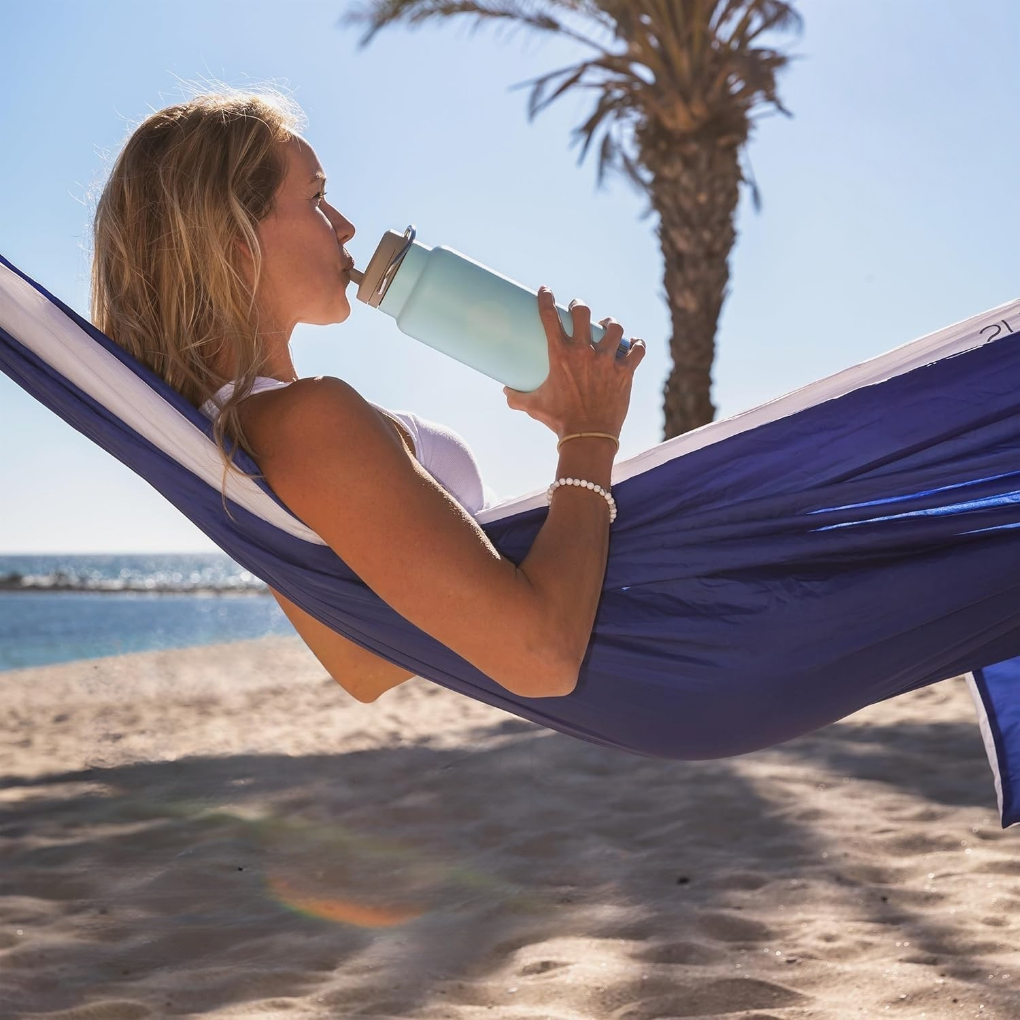
Founded in 2004, Klean Kanteen is a family- and employee-owned B Corporation with distribution in over 40 countries. They pioneered the first BPA-free stainless steel water bottles in the United States, offering a durable and safe alternative to plastic water bottles.
B Corporation Leadership: Certified since 2012, Klean Kanteen earned a B Impact Assessment score of 110.9 — more than double the median score of 50.9 for ordinary businesses.
Climate Commitment: Climate Neutral Certified since 2020 and among the first to earn The Climate Label, they measure Scope 1–3 emissions and implement near-term reduction actions within 12–24 months.
Community Giving: As a 1% for the Planet member since 2008, they’ve donated over $4.4 million to more than 145 environmental nonprofits. They’ve also been a Business Member of the Conservation Alliance since 2009.
Partnerships: Klean Kanteen maintains long-standing collaborations with Leave No Trace (since 2014), 5 Gyres (since 2012), Breast Cancer Prevention Partners, and others to support environmental education, health advocacy, and conservation.
- Material: Made with 90% post-consumer recycled 18/8 stainless steel.
- Certifications: B Corporation, Climate Neutral, 1% for the Planet, Intertek
Soulbottle
$30
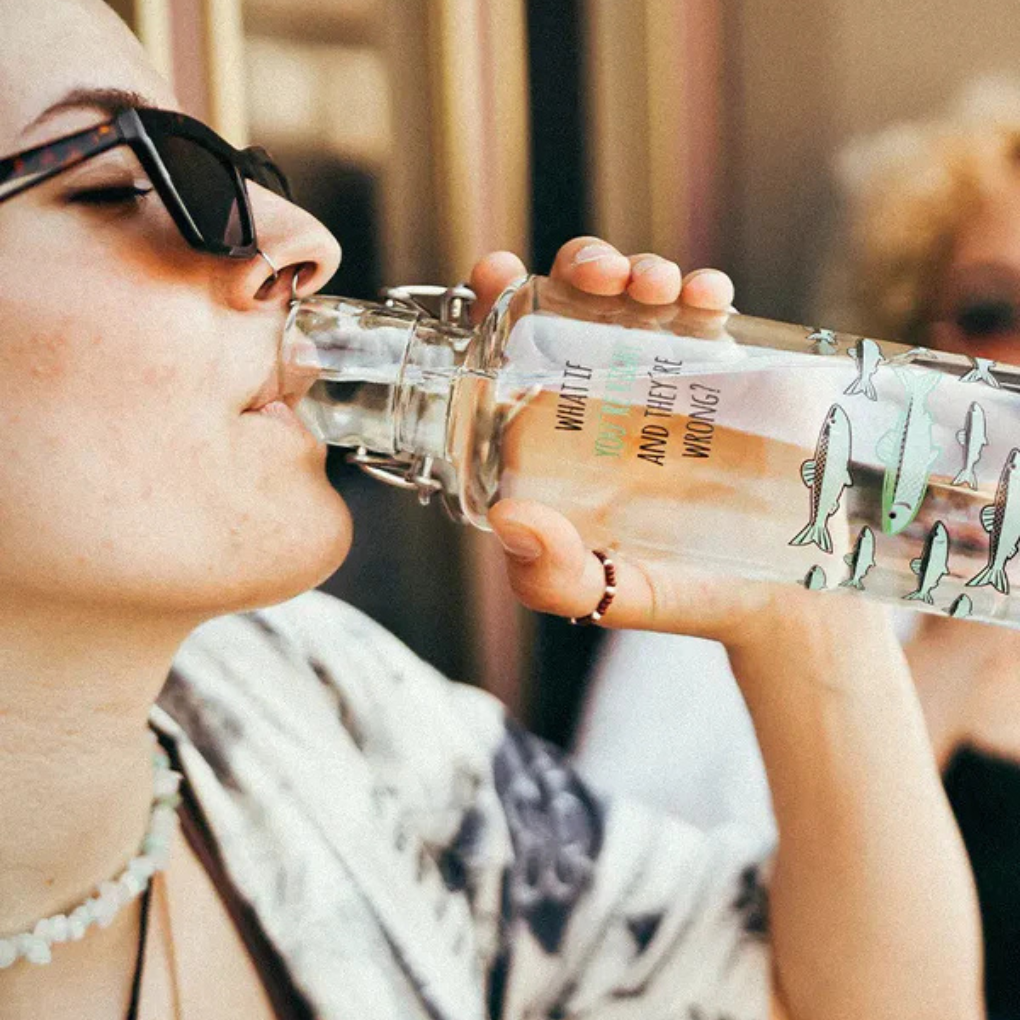
I’m drawn to Soulbottle’s playful, artistic designs that make hydration feel more personal and meaningful. What sets them apart is their incredible social impact—each bottle sold contributes €1 toward clean water access through the WASH’n’soul project, helping thousands gain safe drinking water.
Recycled Glass Innovation: Bottles are crafted using 60-80% recycled glass content, giving new life to waste materials while maintaining premium quality and durability.
Climate-Neutral German Production: All bottles are climate-neutrally produced in Germany, supporting local manufacturing while minimizing environmental impact through verified carbon offset programs.
Artisanal Craftsmanship: Every bottle is individually mouth-blown by skilled glassmakers, supporting traditional craft techniques while creating unique, plastic-free hydration solutions.
Circular Design Philosophy: The bottles are designed for infinite reuse with easily replaceable components, and the glass is 100% recyclable at end-of-life without quality loss.
- Material: Premium borosilicate glass (60-80% recycled content, thermal shock resistant), natural cork from sustainably managed Portuguese forests, porcelain lid options, natural rubber seals.
- Certifications: B Corporation, FSC-certified cork components from sustainably managed forests, Climate-neutral certified operations through ClimatePartner.
Ocean Bottle
$50
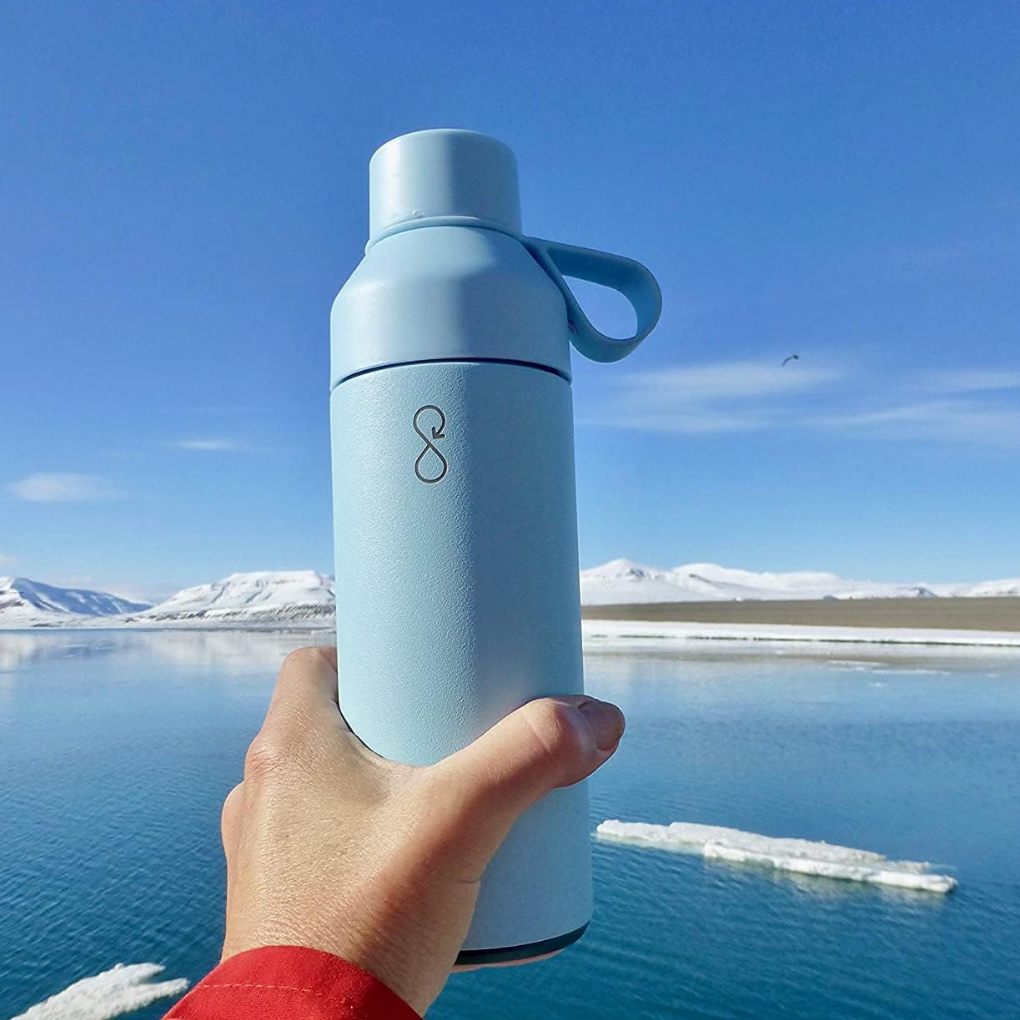
Ocean Bottle is a UK-based B-Corporation founded in 2019 with a bold mission to tackle plastic waste before it ever reaches the oceans. More than just a reusable water bottle company, Ocean Bottle has positioned itself as “The World’s Most Needed Reusable Water Bottle” by creating a direct link between hydration and ocean cleanup.
Ocean Plastic Collection Mission: For every Ocean Bottle sold, the company funds the collection of 11.4kg (25 lbs) of ocean-bound plastic, equivalent to 1,000 plastic bottles. They work with plastic collection partners Plastic Bank, Plastics for Change, and rePurpose Global to establish collection points in coastal communities within 30 miles of the ocean, including rivers and waterways.
Climate Action Commitment: As a Climate Pledge Friendly certified brand, Ocean Bottle has committed to reaching net-zero carbon emissions by 2040. They transport products by train and sea (not air), which reduces transportation emissions by 94%, and eliminated airfreight for 99.71% of shipments in 2022.
Circular Design Philosophy: All Ocean Bottle models are designed for full disassembly, enabling proper recycling and avoiding composite waste.
- Material: Minimum 65% recycled materials including 95% certified recycled stainless steel, BPA-free components
- Certifications: B Corporation, Climate Pledge Friendly, BSCI factory audit standards for ethical production, GRS (Global Recycled Standard) certified materials
Hydro Flask
$40

Since 2009, Hydro Flask has been a pioneer in sustainable hydration, helping to eliminate single-use plastic waste with its durable, reusable stainless steel bottles. With over 50 million bottles in use, the brand has made a measurable impact by reducing demand for disposable alternatives.
Trade-In & Recycling Program: Hydro Flask launched the first-of-its-kind water bottle trade-in program in 2023, where customers can return old, unwanted, and non-functioning Hydro Flask products in exchange for $5 store credit. The returned products are disassembled and sorted to recycle as much material as possible into circular economy streams.
Packaging Innovation: Hydro Flask eliminated single-use plastic packaging for more than 90% of their products, equivalent to 13 million single-use plastic bottles. Their first recycled-content product, the Slingback Bottle Pack, uses 100% recycled polyester.
Climate Action: As a founding member of the Outdoor Industry Association’s Climate Action Corp, Hydro Flask works with companies across the outdoor industry to measure, plan, reduce, and share climate progress.
- Material: 18/8 food-grade stainless steel
- Certifications: FSC-certified packaging, How2Recycle labeling for packaging, and alignment with the Science Based Targets initiative (SBTi) goals through parent company Helen of Troy Limited.
Stasher
$30
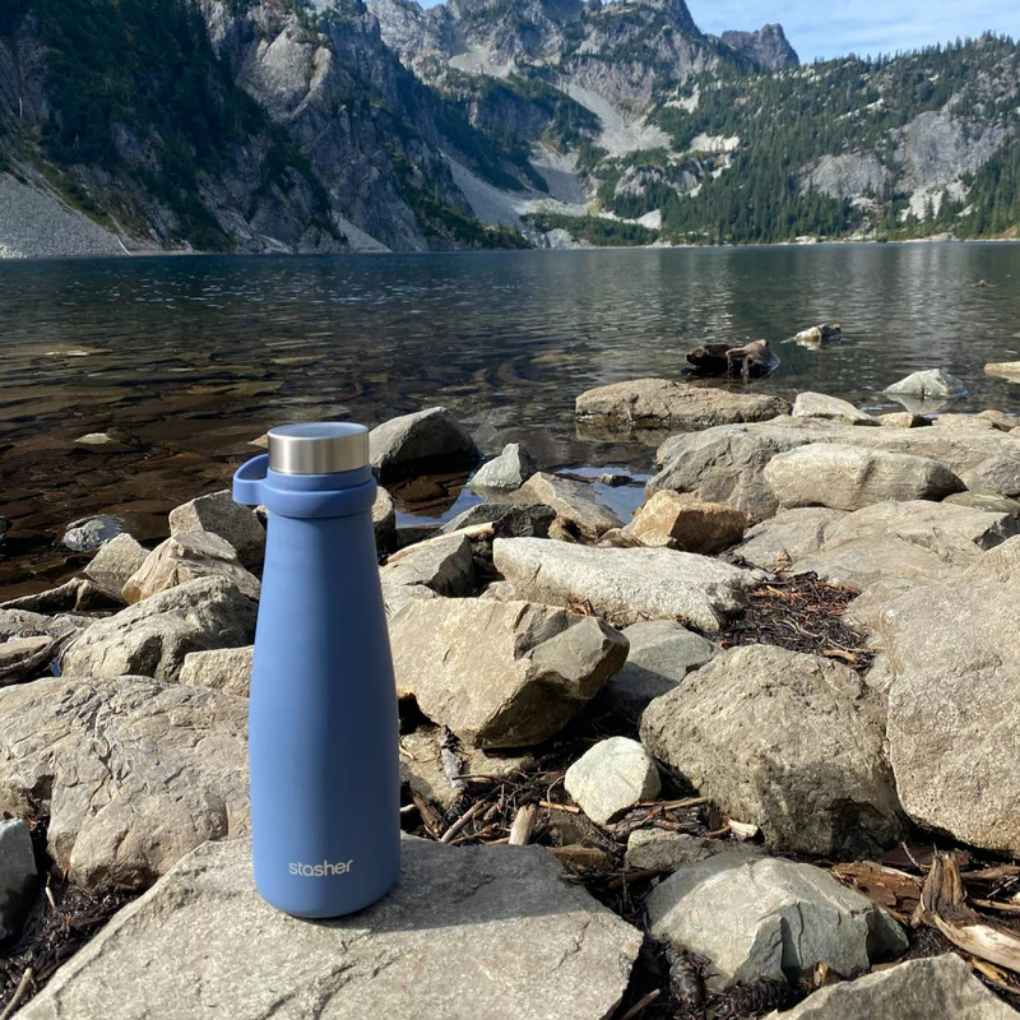
Founded in 2016 by Kat Nouri, Stasher set out to provide a reusable solution to single-use plastic bags. Best known for its silicone food storage bags, the brand also offers a sustainable water bottle that combines a stainless steel core with their signature silicone exterior for durability and grip.
Million Bottle Project: S’well supported UNICEF water programs through multi-year donations totaling over $1.35 million, helping provide clean water access to hundreds of thousands.
Recycling Program with TerraCycle: Stasher partners with TerraCycle to offer a take-back program for worn or damaged products, ensuring materials are responsibly recycled rather than sent to landfill.
Ongoing Philanthropy: A portion of every sale supports nonprofit organizations dedicated to environmental protection and climate action.
- Material: Exterior: Platinum-grade food-safe silicone. Interior: Non-reactive stainless steel.
- Certifications: B Corporation
S’well
$40
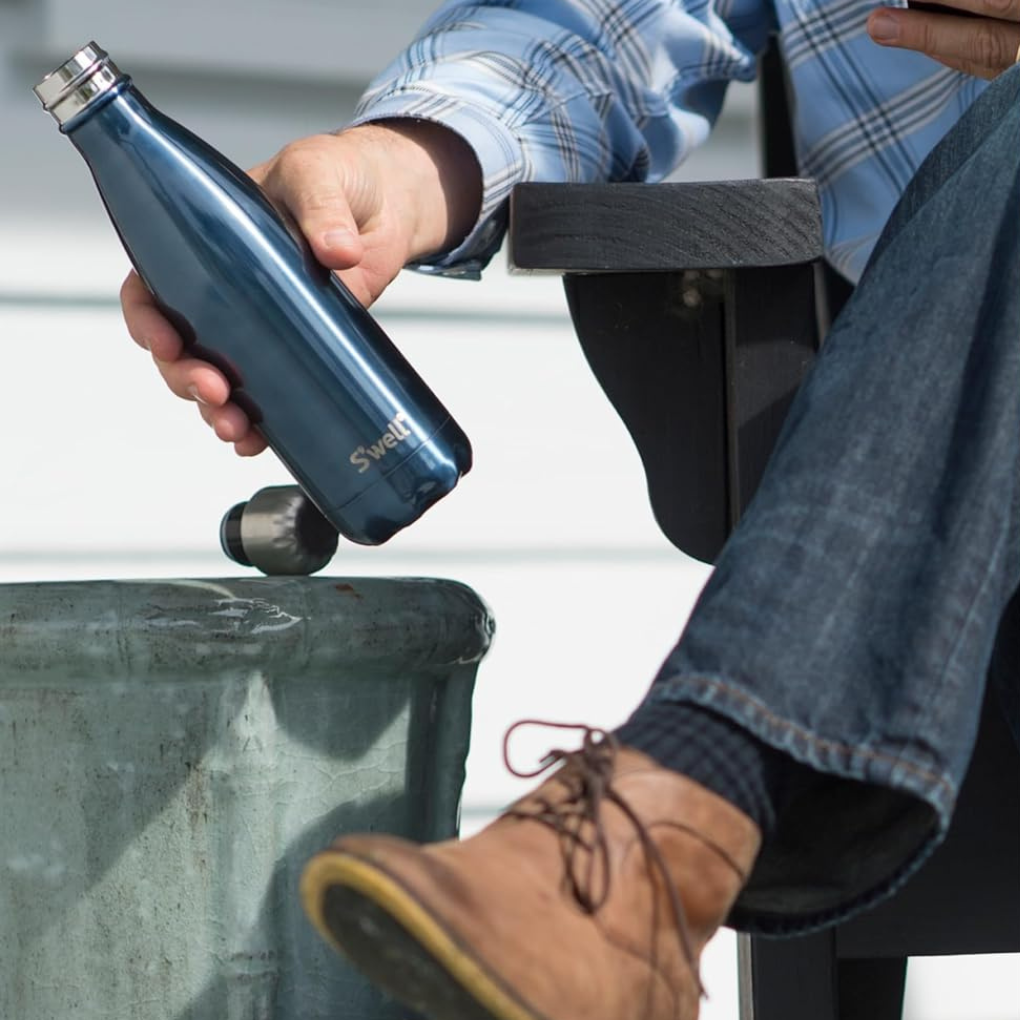
S’well is a design company for good that created the first hydration fashion accessory, founded by Sarah Kauss in 2010, with a mission to rid the world of single-use plastic bottles. The brand focuses on combining sustainability with style.
Water Access Partnerships: S’well devotes a portion of sales to UNICEF programs that help provide clean and safe water to vulnerable communities around the world. This partnership directly addresses global water access issues.
Million Bottle Project: S’well commemorates its mission with initiatives like the Million Bottle Project, celebrating youth sustainability initiatives.
NYC Sustainability Partnership: S’well partnered with the New York City Mayor’s Office of Sustainability on the ‘BRING IT’ campaign to reduce NYC’s plastic problem.
- Material: Triple-layered 18/8 food-grade stainless steel with copper insulation; BPA/BPS-free components.
- Certifications: B Corporation
Bambaw
$18
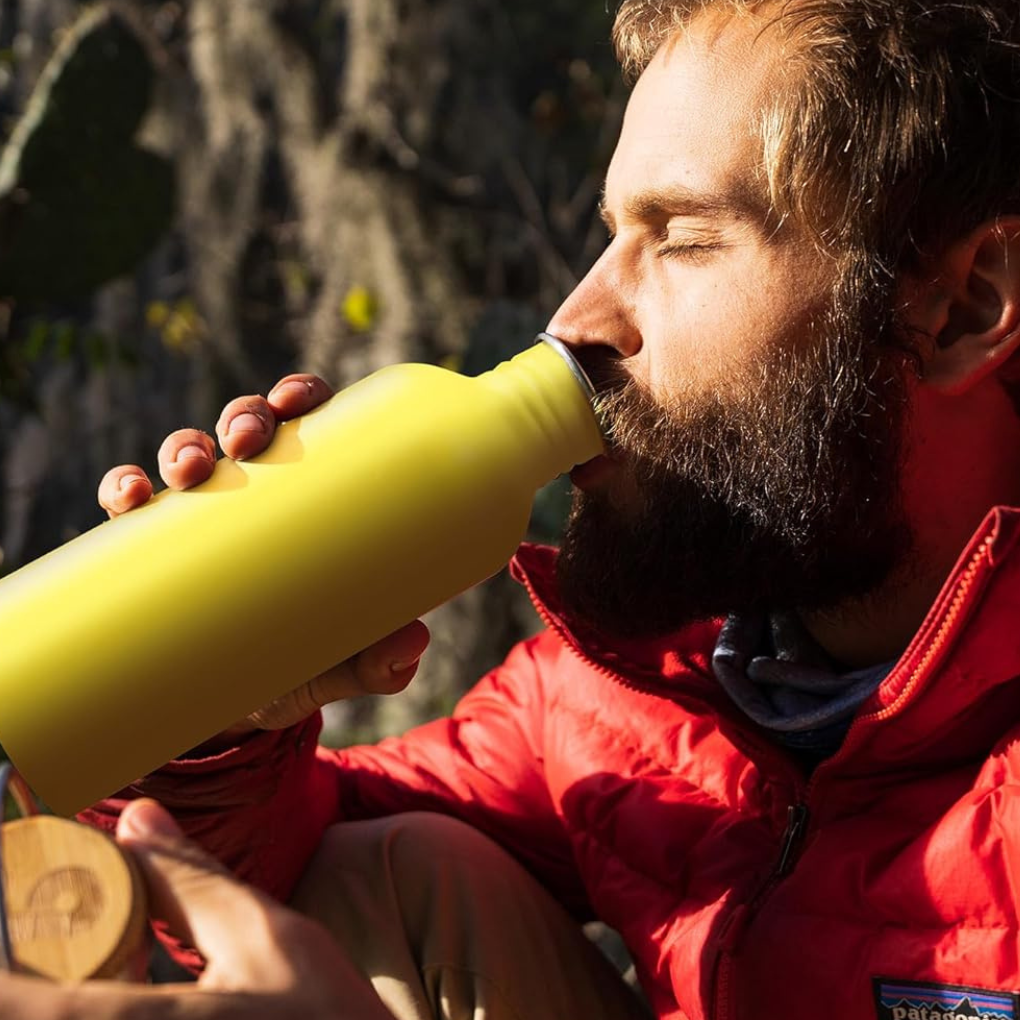
Bambaw is a Belgian zero-waste company founded in 2017 in Brussels by twin brothers Max and Augustin, with a mission to reduce the waste generated on Earth by developing reusable alternatives to single-use products.
Carbon Neutral Operations: Bambaw achieved complete carbon neutrality in 2019, certified by CO2 Logic by PAS 2060 (the international standard for carbon neutrality). The company offsets all emissions from operations, supply chain, and transport by supporting energy-efficient ceramic cooker projects in Malawi.
Zero-Waste Philosophy: Bambaw’s entire business model centers on replacing wasteful single-use items with durable, reusable alternatives. Their products are designed to last a lifetime, reducing the need for frequent replacements and minimizing waste generation.
NGO Partnerships: Bambaw supports two leading NGOs active in plastic pollution research and awareness campaigns: 5 Gyres (which researches plastic pollution in oceans) and the Plastic Soup Foundation (which spreads awareness about plastic pollution problems).
- Material: 304 stainless steel, bamboo lids, BPA/BPS/phthalate-free construction
- Certifications: Carbon Neutral Certified by CO2 Logic (PAS 2060, EU food-grade compliance (DGCCRF 2014-108, EC No 1935/2004)
Greens Steel
$15
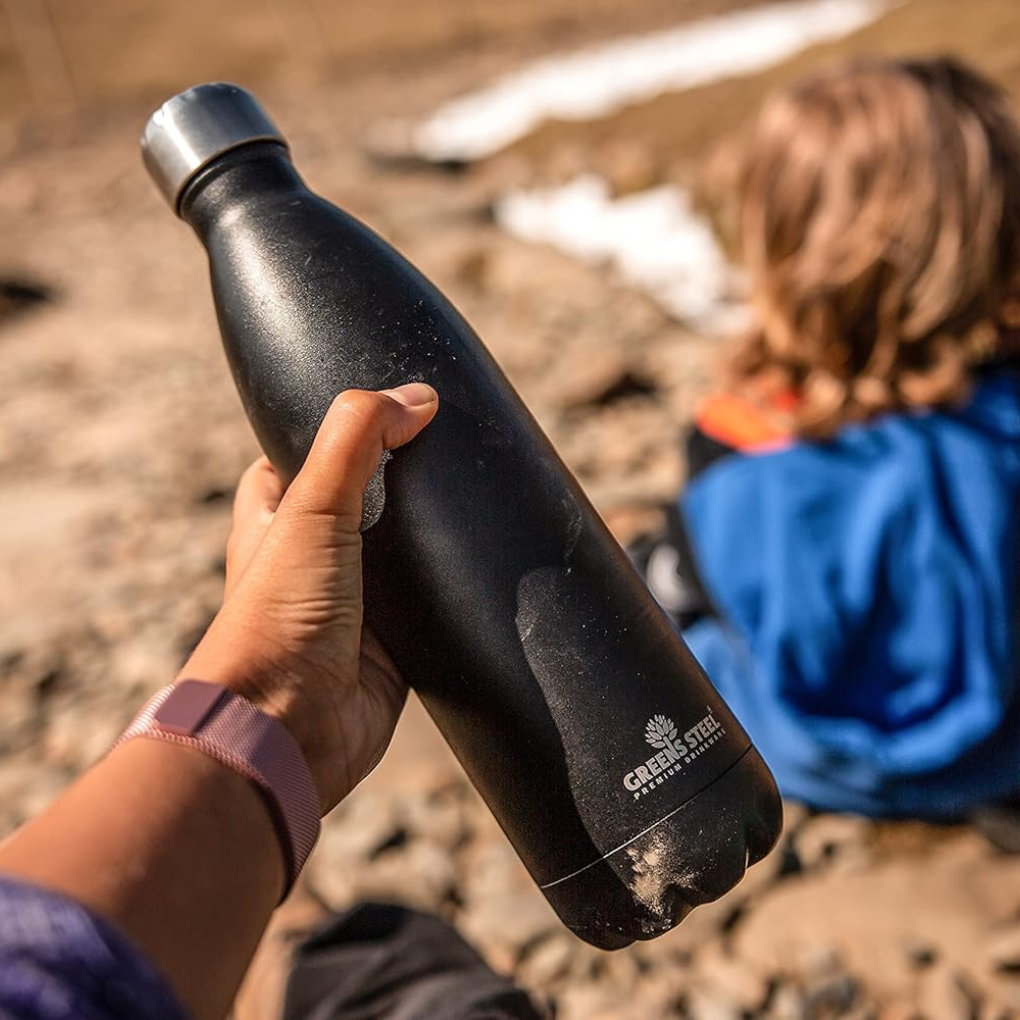
Greens Steel is a sustainability-focused water bottle company committed to reducing single-use plastic waste through premium, durable stainless steel drinkware. The brand emphasizes affordability and quality, believing that sustainable products should be accessible to everyone.
Climate Partnership Certification: Greens Steel products are ClimatePartner certified, meeting requirements for calculating carbon footprints, setting reduction targets, implementing reductions, financing climate projects, and communicating transparently about climate action.
Recycled Steel Materials: Greens Steel bottles are made with recycled steel, contributing to circular economy principles and reducing demand for virgin materials.
Single-Use Plastic Reduction: The company’s core mission focuses on eliminating single-use waste by providing durable, lifetime-use alternatives that replace hundreds of disposable bottles.
- Material: 18/8 304 food-grade stainless steel, BPA-free construction, powder coating finish.
- Certifications: ClimatePartner
Welly
$37

Welly is a US-based company founded by Pittsburgh native Ben Kander in 2015, inspired by his mother Ellen’s memory. Welly creates premium insulated water bottles featuring sustainable bamboo exteriors combined with stainless steel construction, with a mission to empower the world with safe drinking water.
US Manufacturing: Welly is making history as the first insulated steel drinkware brand to be manufactured in the US, with a new facility in Plum Borough, Pennsylvania, bringing production closer to home and creating local jobs.
Clean Water Partnerships: Welly has partnered with Charity Water to improve the lives of women and children globally. The company donates at least 1% of sales to clean water projects worldwide, helping ensure access to safe drinking water for those in need.
Social Impact: Recently, Welly helped fund a community well in Malawi, Africa, directly contributing to water access in developing countries.
- Material: 18/8 food-grade stainless steel, sustainably harvested bamboo, medical-grade silicone, BPA-free plastic components.
- Certifications: No formal product certifications.
Soma
$30
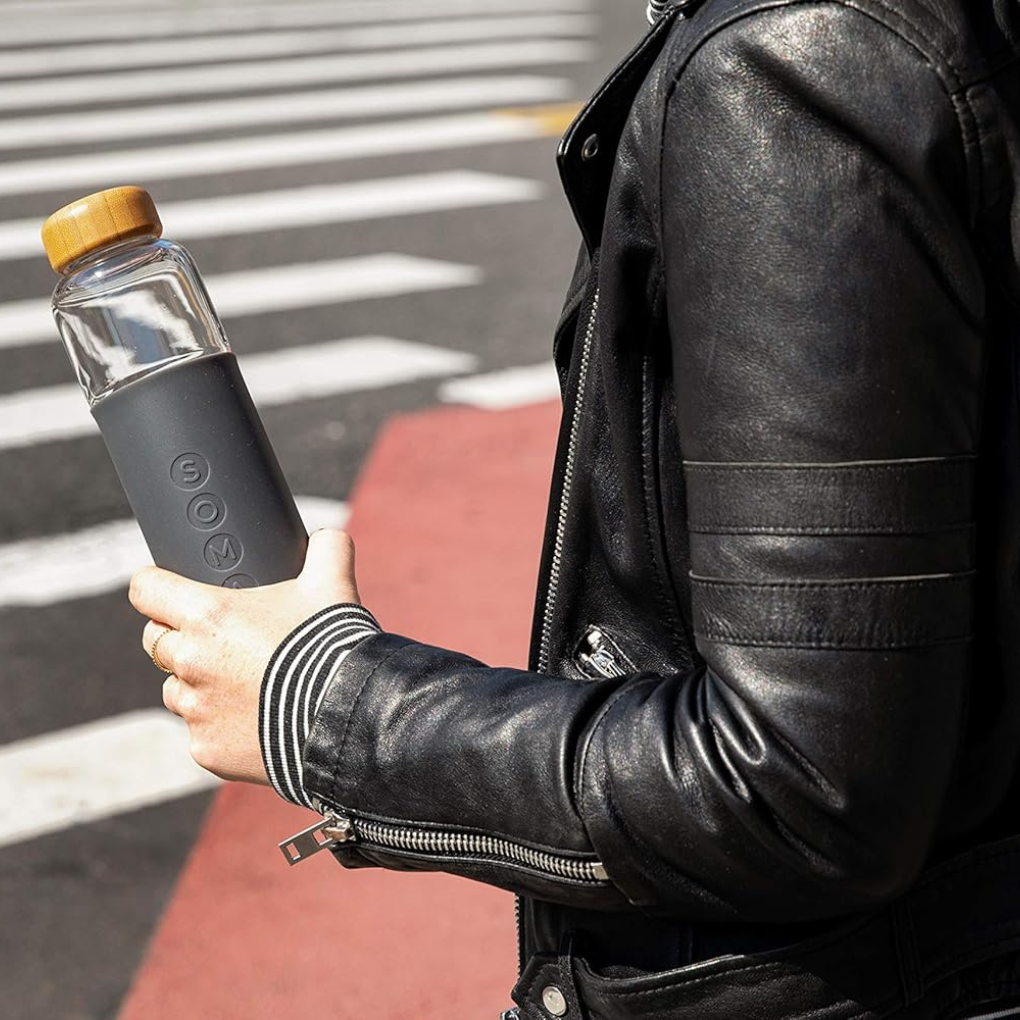
Soma is a certified B-Corporation that makes high-quality, sustainable hydration products, including filtered carafes, water pitchers, glass water bottles, ceramic to-go coffee mugs, and brew bottles. The brand was founded when co-founder Mike didn’t want to put his plastic water filter on the dinner table during a dinner party and instead decanted it into a pitcher. When the lid fell off and water cascaded onto his kitchen floor, the origins of Soma were born.
Water Access Mission: With every Soma product purchase, they donate to charity: water projects, helping address the global water crisis.
Carbon Neutral Operations: They offset emissions with conservation-based forestry projects.
Sustainable Materials: They use post-consumer waste and recyclable materials in their products. For every ounce of plastic they use, more than one ounce is recycled, making them plastic net zero.
Ethical Supply Chain: Soma’s code of conduct sets standards for labor practices, sustainability, transparency, animal welfare, and anti-discrimination policies. They select producers and manufacturers that follow sustainable, economical, and eco-friendly practices, and source from the exact locations where they base their factories to reduce transportation costs.
- Material: BPA-free borosilicate glass bottle with soft silicone sleeve and natural bamboo lid.
- Certifications: B Corporation
What to Look for When Choosing Plastic-Free Water Bottles
Material Quality and Safety
- 18/8 Food-Grade Stainless Steel: This specific grade resists corrosion and doesn’t leach chemicals. Cheaper bottles may be made from lower-grade steel, which can affect the taste.
- Lead-Free Construction: Ensure that any solder or joining materials are lead-free. Reputable brands will clearly state this.
- Medical-Grade Silicone: For seals and gaskets, medical-grade silicone offers greater durability and enhanced safety compared to less expensive alternatives.
Lid Design and Functionality
- Leak-Proof vs. Spill-Proof: True leak-proof lids can handle being turned upside down in a bag. Spill-proof lids prevent sloshing but may leak under pressure.
- Cleaning Accessibility: Wide-mouth designs (at least 2.5 inches) allow for easy cleaning and ice insertion. Some narrow-mouth bottles require special brushes.
- Replacement Availability: Check if the brand offers replacement lids and seals. This significantly extends the bottle’s lifespan.
Insulation Performance
- Double-Wall vs. Triple-Wall: Triple-wall offers better insulation but adds weight and cost. Double-wall is sufficient for most users.
- Vacuum Insulation: Look for brands that specify vacuum insulation rather than relying solely on air gaps between walls.
Size and Portability
- Standard Sizes: 18-20 oz bottles fit most car cup holders. 32-40 oz options are great for all-day hydration but may be too large for some activities.
- Weight Considerations: Insulated steel bottles can be heavy when full. Consider your intended use—daily commuting, hiking, or gym use.
Why Every Bottle Matters
The sustainability benefits of plastic-free bottles become clear when you look at the actual numbers:
🗑️ Plastic Pollution Reduction
The average American uses about 167 disposable plastic water bottles each year, contributing to an estimated 60 million bottles discarded daily in the U.S. alone. Choosing a reusable water bottle helps eliminate this single-use waste stream and reduces the spread of microplastics into waterways, soil, and food systems.
🏭 Manufacturing Impact
Producing a stainless steel water bottle typically requires significantly more energy than a single plastic bottle, up to 50 times more by some estimates. However, when used consistently, a reusable bottle can offset this environmental cost within a few months. Over several years of regular use, it prevents the emissions and resource use associated with hundreds of single-use plastic bottles.
🌊 Ocean Bound Plastic
Several brands now use ocean-bound plastic in their products or contribute to marine cleanup programs with every purchase. These efforts support the global response to the estimated 8 million metric tons of plastic waste that enter the oceans annually. Plastic bottle caps and containers remain among the most frequently collected items during international beach cleanups.
♻️ Recycled Materials
Some manufacturers incorporate high levels of recycled stainless steel, typically ranging from 60 percent to 90 percent, into their bottles. This significantly reduces the need for virgin raw materials and lowers the environmental footprint of production, including decreased energy consumption, reduced emissions, and minimized mining-related impacts.
Don’t Miss: Plastic-Free Living If you’re interested in learning more about why reducing your plastic use is so important, this guide explains the reasons and shares practical ways to cut back. Read more →Healthy Hydration Starts with the Right Bottle
Switching to a plastic-free bottle isn’t just about dodging BPA—it’s about protecting your health on multiple levels. From avoiding hidden chemicals to promoting better hydration, the choice between glass, stainless steel, and plastic makes a real difference.
✅ What You Gain with Stainless Steel or Glass
- No Microplastics: Bottled water can contain up to 10,000 particles per liter, but glass and steel bottles keep your drink free from plastic fragments.
- Safe at Any Temperature: Hot beverages, summer heat, or warm cleaning water won’t cause chemical release.
- Fresher Taste, Better Hydration: No lingering odors or flavors. Many people drink 20–30% more water daily because it tastes better.
- No Chemical Leaching: Truly inert materials—no BPA, BPS, phthalates, or hidden additives.
❌ What You Risk with Plastic Bottles
- Microplastic Exposure: Bottled water contains 22x more microplastics than tap water. These particles have been found in human blood, lungs, and even the placenta.
- Heat-Triggered Leaching: At 158°F (similar to the temperature of a hot car), plastics can release chemicals up to 55 times faster.
- Lingering Odors & Taste: Plastic absorbs flavors, making water taste stale and discouraging hydration.
- Hormone-Disrupting Chemicals: Even “BPA-free” plastics often contain other harmful substitutes such as BPS, BPF, or phthalates.
✨tips
Maintenance and Care: Making Them Last
Daily Cleaning
- Stainless Steel: Rinse with warm water after each use. For deeper cleaning, use dish soap and a bottle brush once a week. Avoid using bleach, as it can damage the steel.
- Glass Bottles: These handle aggressive cleaning well. Dishwasher-safe options make maintenance effortless, but hand washing prevents potential thermal shock.
Deep Cleaning Methods
- Odor Removal: Fill with warm water and two tablespoons of baking soda. Let it sit overnight, then scrub and rinse thoroughly.
- Stubborn Stains: White vinegar and rice (as an abrasive) work well for removing residue from coffee or tea.
- Lid Maintenance: Although most plastic-free bottles are made without plastic, they often still contain plastic or silicone components in their lids. Clean these separately and replace gaskets annually for optimal performance.
Storage and Longevity
- Air Drying: Always let bottles dry completely before storing to prevent bacterial growth and odors.
- Replacement Parts: Stock up on replacement gaskets and lids if you find a bottle you love. This can extend its life by years.
- Warranty Coverage: Many premium brands offer limited lifetime warranties. Keep purchase receipts for warranty claims.
FAQs on Best Plastic Free Water Bottles
Yes. Research shows bottled water can contain thousands of tiny plastic particles per liter — including both microplastics and even smaller nanoplastics. These fragments may carry chemical additives or pollutants, and scientists are still studying their long-term health effects. If you’d like to explore the science in more detail, check out our full guide on nanoplastics in bottled water.
Yes. High-quality stainless steel bottles (look for 18/8 food-grade steel) are considered one of the safest materials for drinking water. They don’t leach harmful chemicals, even when exposed to heat, and they’re resistant to rust and corrosion. Just make sure the brand is transparent about using lead-free parts in seams or lids.
Plastic bottles pose both health and environmental risks. Studies show that bottled water can contain 22 times more microplastics than tap water, and heat accelerates the leaching of chemicals. Even “BPA-free” plastic often contains similar hormone-disrupting chemicals. Additionally, billions of bottles end up in landfills and oceans every year. Switching to a reusable plastic-free bottle helps protect both your health and the planet.
Plastic-free bottles usually last for years, sometimes even a decade or more, with proper care. Stainless steel bottles are nearly indestructible and can withstand drops, dents, and daily use. Glass bottles can also last for years, especially when protected with a silicone sleeve.
By contrast, plastic bottles often warp, crack, or leach chemicals within months to a couple of years. Many people on forums report using the same stainless steel bottle for over 5 years, while plastic ones rarely last that long.
Final Thoughts About Plastic-Free Water Bottles
Making the switch to a reusable water bottle represents one of the simplest yet most impactful changes you can make for both your health and the environment. Americans use approximately 50 billion plastic water bottles each year, with less than 25% being recycled; as a result, billions end up in landfills and oceans, where they take hundreds of years to decompose.
By choosing a durable, reusable option, you’re directly reducing demand for single-use plastics while ensuring your water tastes pure and clean every time. Beyond environmental benefits, reusable bottles save money long-term and eliminate exposure to potentially harmful chemicals that can leach from plastic containers.
Featured image is from Amazon.
📚References
- EarthDay.org. (2023). Fact sheet: Single-use plastics. https://www.earthday.org/fact-sheet-single-use-plastics/
- Container Recycling Institute. (n.d.). Down the drain: Plastic water bottles. https://www.container-recycling.org/index.php/issues/…/275-down-the-drain
- EarthDay.org. (2023). Money in a bottle: How bottled water is costing us the planet. https://www.earthday.org/money-in-a-bottle/
- National Geographic. (n.d.). Reusable plastic water bottles: Are they sustainable? https://www.nationalgeographic.com/environment/article/reusable-plastic-water-bottles-sustainable
- World Economic Forum. (2022). Recycling and plastic facts. https://www.weforum.org/stories/2022/06/recycling-global-statistics-facts-plastic-paper/
